Sitting at the wheel of an old Pontiac
 (2000)
(2000)
Here's another item I find so appealing about these cars, simply because it's so different:
the dash! Functional, well laid out, well equipped, but wrapped up in a treatment that looked
like no other instrument panel! Looking about the cabin from left to right, we find a driver's
side vent, the headlamp controls and the wiper controls. The first large pod flanking the steering
wheel is the tachometer/clock combo, which still works perfectly.
 (2000)
(2000)
The base L78 400 is redlined at 5000, but I wouldn't want to take it up there for any
length of time.
Perhaps if I decide to upgrade the engine internals one day and opt for some exotic
high-RPM capability, but certainly not with 170000 km on it! Note
the steady fast idle of 1900 RPM, the choke still works great on the Rochester 4Bbl.
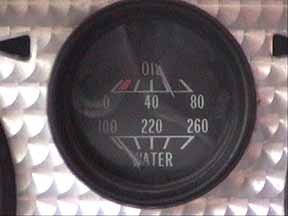 (2000)
(2000)
Immediately over the steering column is the combination oil pressure/water temperature readout,
flanked by the turn signal lamps. Base Pontiac 400s aren't known for high oil pressures, and
will read between 20 and 45-50 depending on engine speed. Thankfully, I'm still well within
specs according to the shop manual.
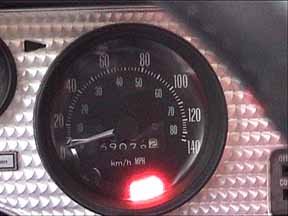 (2000)
(2000)
Moving to the right, we come to the 85 mph speedometer, with metric readings predominating.
The glowing red lamp is the BRAKE light, indicating the parking brake is still set. At this
point, the car is supposedly showing 169000 km... perhaps more? Who knows... there's no guarantee
that the car hasn't already cycled the 5-digit odometer more than once to date!
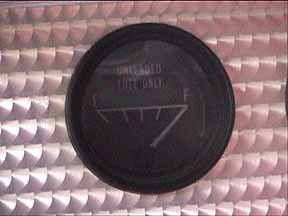 (2000)
(2000)
Here's a sight you don't see too often. The car's 21 gallon fuel tank is full. The unit
appears to read very linearly and I've never found myself in a panic situation worrying about
running out of gas. This is a particular problem on 3rd gens (my GTA) and most 4th gens (not
the 98, thankfully), where the non-linear indicator will find itself plumetting to EMPTY
once it reaches the 1/4-full marking.
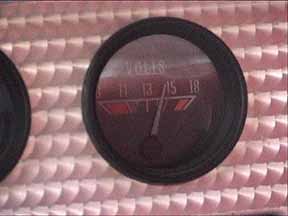 (2000)
(2000)
This is one readout I'll be studying carefully. I have no idea how much longer this alternator
will be pumping out adequate electricity, but so far I've only seen the needle dip into the
yellow warning zone below 12 volts a few times with ALL accessories running (radio, wipers, rear
window defog, heater fan on high speed, headlamps on) on a cold fall night in October.
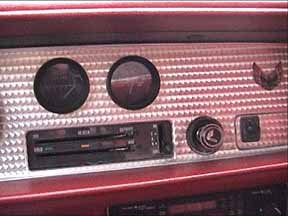 (2000)
(2000)
Had this been an A/C-equipped car, we would have seen two more round air outlets beside the voltmeter,
but on this car this is simply a flat area trimmed with a red cloisonne Firebird badge. Below the
badge is a flip switch for the rear defogger, and I'm sure there's room for another option to the
right of it... I just don't know which one! According to most internet sources,
this control would have been the flip switch for the power door locks. The climate controls are the
base variety, with only 2 settings: heater and front-window defroster. The dash-mounted vents are
controlled by push-rods down by the passenger's and driver's feet. The radio immediately below the
instrument panel is a crappy aftermarket unit.
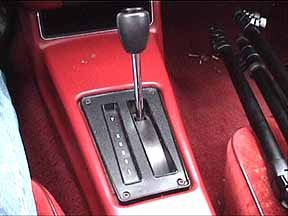 (2000)
(2000)
The console-mounted shifter controls the THM350 3-speed automatic immediately below it. It allows
manual selection of 1st gear ("L"), preventing a 2-3 upshift ("S") and fully automatic ("D"). I
don't know what it is about these shifters that forces one to assume the Burt Reynolds style
of driving with left hand on the wheel and right hand wrapped around the shift knob, but it's
addicting... and feels so natural!
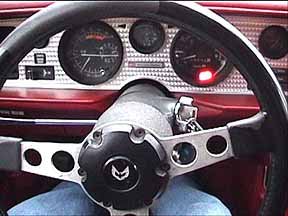 (2000)
(2000)
Speaking of wheel... this is one of the most comforable wheels ever designed. It seems to be
so natural for the car. This particular wheel is in need of a resurfacing. It's another
one of those items that have become synonymous with 2nd gen Trans Ams.
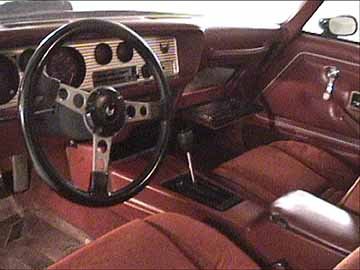 (2000)
(2000)
Perhaps to make up for the pathetic trunk and cramped rear seating, there is ample storage
available for front seat passenger items. There is a glove box (gone from the 3rd gens, to
return only for the 4th gens in 1993) as well as a console storage bin. One curious option
on this car is the red cloth interior, with carpeted lower door panels. Only in the 70's
would something like this work so well...
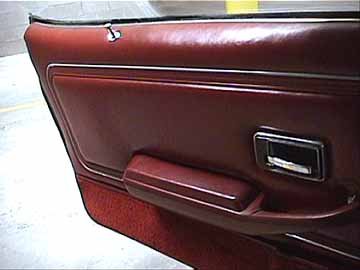 (2000)
(2000)
Saving the best for last, the classic pre-80s foot dimmer switch for the high beams!
 (2001)
(2001)
 (2000)
(2000) (2000)
(2000) (2001)
(2001)